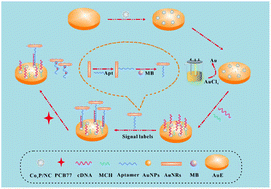An electrochemical aptasensor-based CoxP-decorated porous carbon microspheres and AuNRs labelled methylene blue as signal labels for the sensitive detection of PCB77†
Abstract
In this work, a simple, specific and ultra-sensitive electrochemical aptasensor was successfully developed based on a novel signal reduction strategy for the detection of polychlorinated biphenyls (PCB77). This aptasensor was prepared by the electrodeposition of gold nanoparticles (AuNPs) on an Au electrode (AuE) modified with cobalt phosphide (CoxP, a mixture of CoP and Co2P) decorated porous carbon microspheres. In this study, the thiolated single-complementary DNA (cDNA) was immobilized on the surface of the modified electrode via the Au–S bond. Subsequently, the gold nanorod@methylene blue connection aptamer (AuNRs@MB-Apt) signal labels were immobilized onto the modified electrode through the principle of complementary base pairing. Further, the aptamer preferentially binds to PCB77, decreasing the amount of AuNR@MB-Apt. The DPV current response was related to the PCB77 concentration. Under the optimized experimental conditions, a low detection limit of 5.9 × 10−2 ng L−1 and a wide linear range of 1 × 10−11 mg mL−1 to 1 × 10−4 mg mL−1 (S/N = 3) for PCB77 were achieved. Moreover, the proposed aptasensor offered high selectivity, stability and reproducibility, indicating the broad potential application in environmental monitoring.



 Please wait while we load your content...
Please wait while we load your content...